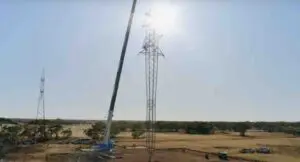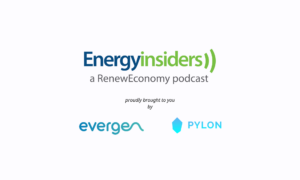I’ve seen the energy future, and it’s in China.
On a recent delegation, I saw the futuristic factory of solar giant Longi in Jiaxing, with its omnipresent robots, combining automation, big data, AI and 5G to flexibly customise solar module components for diverse application scenarios and customers, revolutionising advanced manufacturing at massive scale.
This is not an isolated case. China leads the world by a huge and growing margin across almost all of the frontiers of our decarbonised future, from sophisticated clean tech manufacturing to domestic renewable energy installations to foreign direct investment into the energy transition.
This is good news for Australia – if we make the right strategic choices, informed by a nuanced view of geopolitical dynamics and a sophisticated grasp of where our national interests lie in the burgeoning net-zero world economy.
Australia and China have powerful resource and supply chain complementarities. We have some of the world’s largest reserves of the minerals driving the energy transition, we are world #1 in both iron ore and lithium, and we have superabundant renewables potential.
Australia must look to transition out of its historical overdependence on fossil fuel exports as the latter enter inevitable structural decline. Together, our nations could be writing the next chapter of the global renewable energy industry.
In collaboration, Australia and China could produce any product using green energy – photovoltaics (PV) modules, polysilicon, lithium, iron and steel, ammonia, battery energy storage systems (BESS) – a game changer for the whole energy system, with implications for addressing the existential climate crisis humanity faces.
As John Grimes, CEO of peak industry body the Smart Energy Council said on our recent delegation, “It is the Australia-China relationship that gives the world a fighting chance in addressing climate change”.
However, as Grimes acknowledges, a crude geostrategic lens continues to dominate the Australian government’s thinking on partnership with China.
Political leaders and institutions that oppose the energy transition and/or collaboration with China – these tend to be in the same ideological camp – have weaponised cybersecurity concerns and elevated these disproportionately, obscuring the immense opportunities we have through rational policy to create a trusted environment for renewable energy development, value-added trade and collaboration with China to thrive.
There is a formative example of such partnership. The solar industry was born out of a close collaboration between UNSW Professor Martin Green, who began researching solar cells in 1974, and his PhD student, Dr Zhengrong Shi, who started the first Chinese solar manufacturing company, Suntech Power, in 2001.
Australian research innovation paired with Chinese entrepreneurship led to commercialisation in China, with significant support from Chinese local governments, US investors and German manufacturers.
This was the crucible of China’s PV industry success, which has enabled solar PV to become the cheapest source of energy and driver of the global energy transition.
However, a trust deficit remains a principal barrier to Australia-China renewable energy collaboration.
As Dr Cao Yu, Executive Director of CMBI Capital Management, commented: “The Australian side of the relationship is not stable”, referring to Australia’s partnership in AUKUS, a China containment strategy costing $368bn and now under review by the Trump Administration – funding that could be spent on renewable energy to help solve the world’s largest threat: climate change.
The Lowy Institute’s annual poll confirms the problem. Australians are almost evenly split on whether China is more an economic partner (50%) or security threat (47%). A clear majority (69%) continue to think it likely China will become a military threat to Australia in the next 20 years. About half (49%) say Australia should be attracting less investment from China.
Public opinion is shaped by western media and by longstanding narratives from governments and associated thought leaders. Hawkish opinions on China influenced by the likes of US-sponsored ASPI continue to dominate Australian media; for example, the assertion citing a US energy official that spyware has been found in solar panels made in China.
There is a real opportunity to counter such disinformation so as to create an environment conducive to Chinese collaboration with Australia – one that will help drive our energy security and economic prosperity into the future. China is already Australia’s top trade partner by a country mile.
In fact, if Australia is serious about a Future Made in Australia and becoming a ‘renewable energy superpower’, partnering with China is a must, not optional, as I have previously argued.
That this simple pragmatism has not found its way into the Australian government’s thinking lies in what Treasurer Chalmers aptly characterised as the “fault line between the nostalgists and the strategists”.
We need nothing less than a reorientation to a strategic mindset and policy and regulatory environment that welcomes Chinese private investment into Australia, guided of course by Australia’s national interests. For example, as we have argued elsewhere, opaque FIRB rules that currently disincentivise investment should be reformed to align with our domestic .
Ultimately, China has demonstrated the pivotal role of government in shaping an resilient, decarbonised future. Strategic intent and a framework of short, medium and long term policy, regulatory and investment support have been critical to the global success of China’s renewable energy industry.
Australia did not have a long-term national renewable energy strategy until the 2022 Climate Change Act – unlike China, with its 2005 Renewable Energy Law, which helped aggressively drive what is now its world energy transition domination.
We have been too slow to date in getting national interest public capital investment out the door, though this is starting to accelerate under the green reindustrialisation initiatives of the Albanese government.
We also need coordinated and future-focussed national policy to build the domestic clean energy workforce that will underpin a future net zero economy. This requires massive investment in reskilling our workforce. There is an opportunity here to partner with China, which has the largest renewable energy workforce in the world. Overcapacity in its solar PV sector means that there is an oversupply of higher skilled engineers, whom we could invite to Australia to help train our workforce.
A major challenge for FMIA is the labour cost, as Shitao Wang, CEO of Huzhou Leapting Technology, pointed out. Automation helps to solve this and is already in place in China. Robots need maintenance in the long term, so jobs in maintenance rather than assembly will also increase. Has the Australian government factored in rising automation in FMIA? This is another area where Chinese expertise could be leveraged.
As the world decarbonises, countries around the world have been sending government and technical delegations to China to learn and partner. China is an outstanding source of knowledge and experience that Australia can and should learn from and apply in our own context. Partnerships, collaboration and co-investment on transformative new energy and resource value-add projects are a critical vehicle for this.
Rebuilding trust with China is not naive. It is smart strategy. We need Chinese supply chains, technology, experience and expertise to achieve the speed and scale of economic, industrial and energy transformation required to secure Australia’s prosperity in the renewable energy age.
China spent over three decades since Deng Xiaoping’s ‘opening up’ policy rigorously learning from the West to modernise its economy. Now China has not only caught up, but surpassed the US and Europe by a long mile in the clean tech race.
Australia should acknowledge this and see China as a partner rather than a competitor. Even the UK gets this, when it recently signed a clean energy partnership MOU with China. We need to lose the arrogance. And we need to make climate and energy collaboration the centre of the bilateral relationship.
Caroline Wang is a China policy analyst with Climate and Energy Finance.






